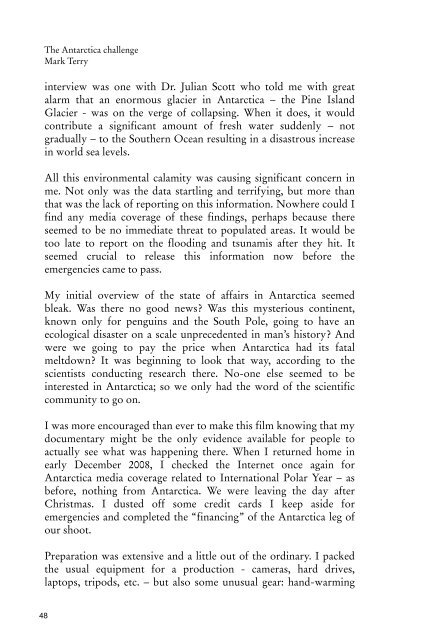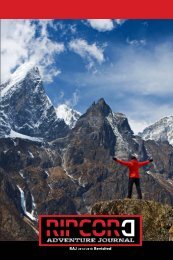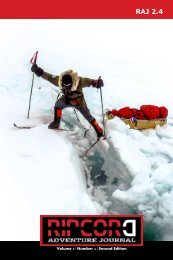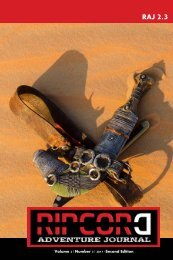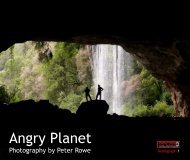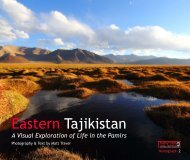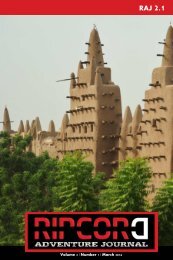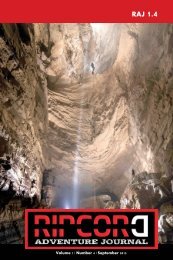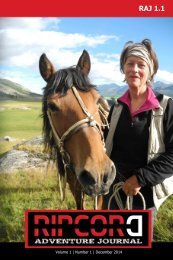Ripcord Adventure Journal 1.3 Second Edition
We begin this issue with a call to adventure from Bear Grylls' Mission Survive expedition and survival expert Megan Hine which is followed by a filmmaking expedition to the icy desert of Antarctica. Our writers have crossed the Himalaya and have cycled around the world to make sure it is indeed round. We hear of legendary explorer John Rae and venture to Kilimanjaro to witness a high altitude rescue. Brought to you by the crew at World Explorers Bureau and Ripcord Travel Protection
We begin this issue with a call to adventure from Bear Grylls' Mission Survive expedition and survival expert Megan Hine which is followed by a filmmaking expedition to the icy desert of Antarctica. Our writers have crossed the Himalaya and have cycled around the world to make sure it is indeed round. We hear of legendary explorer John Rae and venture to Kilimanjaro to witness a high altitude rescue. Brought to you by the crew at World Explorers Bureau and Ripcord Travel Protection
Create successful ePaper yourself
Turn your PDF publications into a flip-book with our unique Google optimized e-Paper software.
The Antarctica challenge<br />
Mark Terry<br />
interview was one with Dr. Julian Scott who told me with great<br />
alarm that an enormous glacier in Antarctica – the Pine Island<br />
Glacier - was on the verge of collapsing. When it does, it would<br />
contribute a significant amount of fresh water suddenly – not<br />
gradually – to the Southern Ocean resulting in a disastrous increase<br />
in world sea levels.<br />
All this environmental calamity was causing significant concern in<br />
me. Not only was the data startling and terrifying, but more than<br />
that was the lack of reporting on this information. Nowhere could I<br />
find any media coverage of these findings, perhaps because there<br />
seemed to be no immediate threat to populated areas. It would be<br />
too late to report on the flooding and tsunamis after they hit. It<br />
seemed crucial to release this information now before the<br />
emergencies came to pass.<br />
AAAAAAAAAAAAAAAAAAAAAAAAAAAAAAAAAA<br />
AAAAAAAAAAAAAAAAAAAAAAAA<br />
My initial overview of the state of affairs in Antarctica seemed<br />
bleak. Was there no good news? Was this mysterious continent,<br />
known only for penguins and the South Pole, going to have an<br />
ecological disaster on a scale unprecedented in man’s history? And<br />
were we going to pay the price when Antarctica had its fatal<br />
meltdown? It was beginning to look that way, according to the<br />
scientists conducting research there. No-one else seemed to be<br />
interested in Antarctica; so we only had the word of the scientific<br />
community to go on.<br />
I was more encouraged than ever to make this film knowing that my<br />
documentary might be the only evidence available for people to<br />
actually see what was happening there. When I returned home in<br />
early December 2008, I checked the Internet once again for<br />
Antarctica media coverage related to International Polar Year – as<br />
before, nothing from Antarctica. We were leaving the day after<br />
Christmas. I dusted off some credit cards I keep aside for<br />
emergencies and completed the “financing” of the Antarctica leg of<br />
our shoot.<br />
Preparation was extensive and a little out of the ordinary. I packed<br />
the usual equipment for a production - cameras, hard drives,<br />
laptops, tripods, etc. – but also some unusual gear: hand-warming<br />
48


